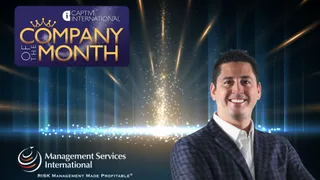
Innovative use of unrated and non-admitted paper in captive insurance
Jeremy Colombik (pictured), managing partner at MSI, explains why leveraging unrated & non-admitted paper can provide clients with a strategic advantage.
In today’s evolving insurance landscape, traditional coverage often falls short of meeting the specific needs of certain businesses, especially when it comes to hard-to-place risks or specialty coverages. This gap in the market is precisely where Jeremy Colombik, President of Management Services International (MSI), believes captives—particularly those leveraging unrated and non-admitted paper—can make a transformative difference.
MSI, a prominent captive management firm, has carved a niche by offering clients innovative solutions using unrated and non-admitted carriers to access flexible and rapid underwriting. These mechanisms enable clients to secure tailored coverage that might otherwise be unavailable or unaffordable through conventional insurance providers.
The Power of Unrated and Non-Admitted Paper
Colombik explained that MSI often introduces the use of unrated and non-admitted paper for clients seeking bespoke insurance solutions. “We have the option to introduce the use of unrated and non-admitted paper for our clients to write specialty, hard-to-place risks and other coverages that may not need to be written on rated or admitted paper,” he said. “The underwriting is quicker and the opportunity to manuscript policies provides an opportunity for clients to purchase the coverage they need.”
This approach is particularly valuable in scenarios where traditional insurers are unable—or unwilling—to provide specific terms, such as higher sub-limits or broader exclusions. “Those entities that request proof of coverage are starting to demand coverages that the traditional market may not be willing to write,” Colombik added. “This can be exclusions being brought back into the coverage form or increasing sub-limits to match full policy limits.”
Unrated carriers offer significant advantages in this context because they assess clients on an individual basis rather than generalising across entire industries. “Rated carriers are often more strict on their coverage offerings and look at industries as a whole,” said Colombik. “With one unrated carrier that we have access to, they individually underwrite each client based on their risk profile. They offer flexible and creative opportunities to structure policies in conjunction with them taking risk to find a mutually beneficial arrangement.”
The Role of Non-Admitted Paper
Similarly, non-admitted carriers are proving indispensable for clients who require speed and agility. Colombik highlighted the regulatory constraints that come with admitted carriers: “Non-admitted paper gives the carrier flexibility to write one-off policies where a rated carrier is required to file rates and forms in each state that they want to operate in. This can be an arduous and expensive process often delaying the needed coverage.”
For admitted carriers, the approval process necessitates scale, expected profit margins, and a larger base of insureds. “Usually, if an admitted carrier is going to write a policy form that they need to get approved, there has to be some scale expected to achieve desired profit and premium projections,” Colombik noted. By contrast, non-admitted carriers can step in more swiftly and with greater agility. “They can settle for less premium if the policies have enough premium and have favourable losses.”
Combining Flexibility and Strategy
In some instances, MSI’s clients leverage both unrated and non-admitted paper simultaneously, opening up a world of possibilities. “If a client doesn’t have the restriction of needing a rated and admitted carrier the possibilities are only bound by their creativity,” said Colombik. “If the insured has the capital and risk tolerance, they can create their own policies or programs for niche or underserved verticals, allowing them to capitalise on a hole in the market.”
A striking example of this occurred during the COVID-19 pandemic. “COVID was a great example of needs that popped up with businesses that needed custom policies quickly to stay in business,” he explained. “A non-admitted and unrated carrier can step in and launch a program in weeks rather than months allowing for business to resume with the comfort that they are insured.”
Captives as a Strategic Reinsurance Vehicle
Crucially, the interplay between unrated/non-admitted carriers and captives allows for optimal risk retention and transfer. Captive owners can strategically write policies through a non-admitted, unrated fronting carrier and then reinsure a portion of the risk into their captive. This structure offers unparalleled flexibility and financial efficiency.
“A captive owner can write an insurance policy that may be needed to procure a contract or feel comfortable to expand their operations,” Colombik said. “While this may be cost prohibitive in the commercial markets, they can use a non-admitted and unrated carrier to write a policy and then reinsure as much risk as they would like back into their captive.”
For instance, if a business is primarily concerned about catastrophic (cat) events rather than frequent small claims, it can retain the lower frequency layer within the captive, while ceding the catastrophic layer. “In the case where they are concerned about cat risk but not frequency, they can reinsure the frequency layer in their captive and if they don’t have any losses keep the underwriting profit,” Colombik added.
Profit Through Better Risk Management
This model not only empowers businesses to control their risk but also allows them to benefit financially from good risk management. “Knowing that they can keep the lion’s share of the premium with good losses encourages them to take the reinsurance risk in their captive,” he explained.
“Many individuals think the cost of insurance is too high and that they don’t have many losses. This provides them with the opportunity to profit off of their good risk management practices while safeguarding against cat losses.”
Final Thoughts
The strategic deployment of unrated and non-admitted paper in combination with captive reinsurance is gaining traction among sophisticated risk managers. Under the stewardship of Jeremy Colombik and MSI, businesses are increasingly able to navigate regulatory complexity, improve coverage customisation, and reclaim profitability from insurance spend.
As commercial markets remain rigid and occasionally unresponsive, captives—particularly those supported by non-traditional fronting structures—offer a viable, flexible, and financially rewarding alternative. For businesses prepared to embrace innovation and assume responsibility for their risk, the rewards can be substantial.
Did you get value from this story? Sign up to our free daily newsletters and get stories like this sent straight to your inbox.

